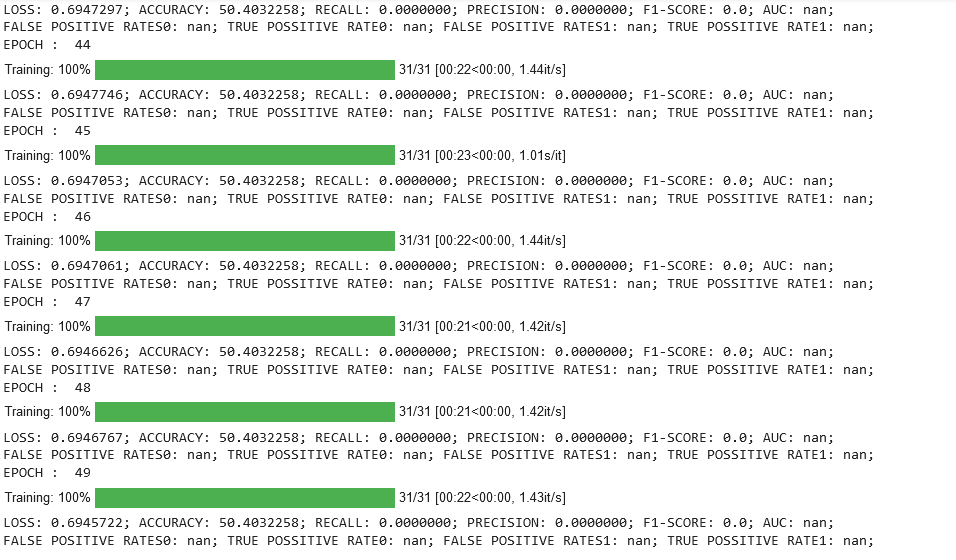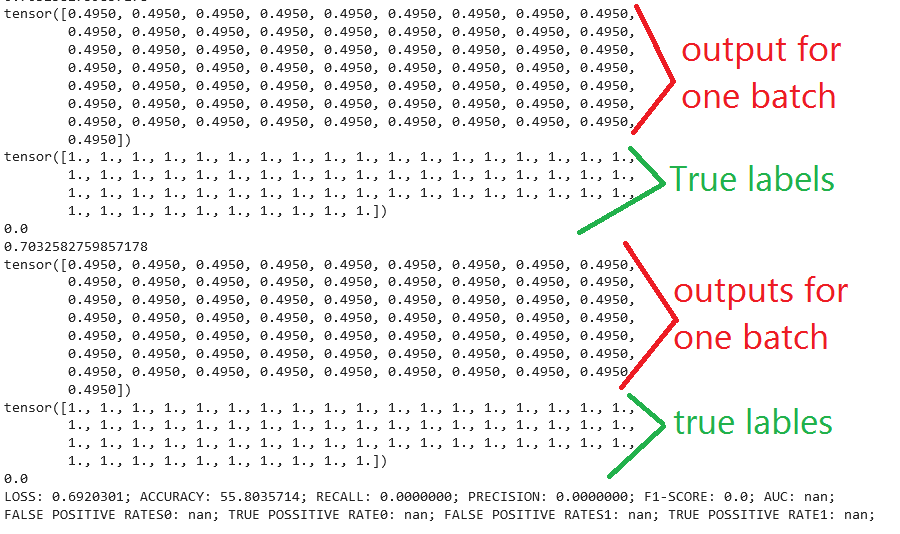I’m trying to implement an LSTM NN to classify spam and non-spam text. It seems that the model is not trained and the loss does not change over epochs, so it always predicts the same values. At the latest time, it predicts [ 0.4950] for all test samples so it always predicts class as 0. The number of EPOCHs is 50 and LR is 0.0001 with adam (and SGD) optimizer (I tried 0.001 as LR but I got the same results). I’m really confused about the reason for this issue. What is the problem?
my classifier is:
class LSTM_clf(nn.Module):
def __init__(self, embed_size, hidden_size, vocab_size, num_layers, num_classes, batch_size,max_seq_len):
super(LSTM_clf, self).__init__()
self.embed_size = embed_size
self.hidden_size = hidden_size
self.batch_size = batch_size
self.num_layers = num_layers
self.max_seq_len=max_seq_len
self.gpu= torch.cuda.is_available()
self.embedding = nn.Embedding(vocab_size, embed_size)#.cuda()# Initializing the look-up table.
# self.embedding.load_state_dict({'weight': torch.Tensor(emb_weights)}) # Assigning the look-up table to the pre-trained GloVe word embedding.
self.lstm = nn.LSTM(embed_size, hidden_size, num_layers, dropout=0.3, bidirectional=True)
self.lstm2out = nn.Linear(2*hidden_size, vocab_size)
self.hidden2out = nn.Linear(2*hidden_size, 1)
self.hidden=self.init_hidden()
self.fc = nn.Sequential(
nn.Linear(2*hidden_size, 100),
# nn.ReLU(),
# nn.Dropout(p=0.2),
nn.Linear(100, 1),
# nn.view(-1)
)
def init_hidden(self):
h = Variable(torch.zeros((2*self.num_layers, self.batch_size, self.hidden_size)))#.cuda()
c = Variable(torch.zeros((2*self.num_layers, self.batch_size, self.hidden_size)))#.cuda()
return h, c
def forward(self, x):
# print('inp size: ',x.size()) # x: Seq_len*Batch_size
x = self.embedding(x)
self.hidden=self.init_hidden() #
# print('hidden size: ',self.hidden[0].size())
x, self.hidden = self.lstm(x, self.hidden) #x: seq_len * Batch_size* Batch_size
# print('LSTM_X: ',x.size())
x = self.hidden2out(x[-1]) # select the last output : 1*Batch_size
# print('h2out_size: ',x[-1].size())
out = torch.sigmoid(x)
# print('out:', out.shape)
return out.view(-1)
train method:
clf =LSTM_clf(embed_size=EMBEDDING_DIM,
hidden_size=LSTM_HIDDEN_DIM,
vocab_size=VOCAB_SIZE,
num_layers=2,
num_classes=2,
batch_size=BATCH_SIZE,max_seq_len=MAX_SEQ_LEN)
clf_optimizer = optim.Adam(clf.parameters(),lr = CLF_LR)
clf_criterion = nn.BCELoss() #nn.CrossEntropyLoss()
best_loss = float('inf')
for epoch in range(1 , EPOCHS+1):
print("EPOCH : " , epoch)
loss ,acc ,rcl ,prc ,f1 ,auc ,fpr0 ,tpr0 ,fpr1 ,tpr1 = train_classifier(clf, train_dl, clf_criterion, clf_optimizer)
print(f"LOSS: {loss:.7f}; ACCURACY: {acc*100:.7f}; RECALL: {rcl:.7f}; PRECISION: {prc:.7f}; F1-SCORE: {f1}; AUC: {auc}; ")
print(f"FALSE POSITIVE RATES0: {fpr0}; TRUE POSSITIVE RATE0: {tpr0}; FALSE POSITIVE RATES1: {fpr1}; TRUE POSSITIVE RATE1: {tpr1};")
def clf_training(model, train_inputs, train_labels, optimizer, criterion,filename=''): #for one iteration
# model.hidden = repackage_hidden(model.hidden)
train_inputs, train_labels = Variable(train_inputs), Variable(train_labels).float()
optimizer.zero_grad()
output = model(train_inputs.long().t())
loss = 0
loss = criterion(output, train_labels)
loss.backward(retain_graph=True)
optimizer.step()
loss = loss.data.item()#[0]
acc= accuracy_score((output>0.5).float().cpu(), train_labels.cpu())#.item()
rcl= recall_score((output>0.5).float().cpu(), train_labels.cpu()).item()
prc= precision_score((output>0.5).float().cpu(), train_labels.cpu()).item()
f1= f1_score(train_labels.cpu() , (output>0.5).float().cpu()).item()
fpr, tpr, thresholds = roc_curve(train_labels.cpu(), (output).float().cpu().data.numpy())
auc_s = metrics.auc(fpr, tpr) #roc_auc_score(train_labels.cpu(), (output).float().cpu()) # metrics.auc(fpr, tpr)
# auc = auc(recall, precision)
return acc, rcl, prc, f1, auc_s , fpr, tpr, loss, (output>0.5).float()
def train_classifier(model, train_dl, criterion, optimizer,filename='', i=0): #for one epoch
model.train()
total_acc=0
total_rcl=0
total_prc=0
total_f1=0
total_auc=0
total_loss_clf=0
total_loss_gen=0
total_fpr0=0
total_tpr0=0
total_fpr1=0
total_tpr1=0
total=len(train_dl)
probs=[]
for i, (train_inputs, train_labels) in tqdm_notebook(enumerate(train_dl), desc='Training', total=len(train_dl)):
# print("ITER : " ,i)
acc, rcl, prc, f1, auc_s,fpr,tpr, loss_clf,_= clf_training(model, train_inputs, train_labels, optimizer, criterion, filename)
total_acc+=acc
total_rcl+=rcl
total_prc+=prc
total_f1+=f1
total_auc+=auc_s
total_loss_clf+=loss_clf
total_fpr0+=fpr[0]
total_tpr0+=tpr[0]
total_fpr1+=fpr[1]
total_tpr1+=tpr[1]
return total_loss_clf/total, total_acc/total ,total_rcl/total ,total_prc/total ,total_f1/total ,total_auc/total, total_fpr0, total_tpr0, total_fpr1, total_tpr1
evaluate model:
def evaluate_classifier(model, test_inputs, test_labels, criterion):
loss = 0
test_inputs, test_labels = Variable(test_inputs), Variable(test_labels).float()
output = model(test_inputs.long().t())
loss = criterion(output, test_labels)
loss= loss.data.item()
print(loss)
print(output)
print(test_labels)
acc= accuracy_score((output>0.5).float().cpu(), test_labels.cpu()).item()
print(acc)
rcl= recall_score((output>0.5).float().cpu(), test_labels.cpu()).item()
prc= precision_score((output>0.5).float().cpu(), test_labels.cpu()).item()
f1= f1_score((output>0.5).float().cpu(), test_labels.cpu()).item()
fpr, tpr, thresholds =roc_curve(test_labels.cpu(), (output).float().cpu().data.numpy())
auc_s = metrics.auc(fpr, tpr)
return acc, rcl, prc, f1, auc_s , fpr, tpr, loss, (output>0.5).float()
def test_classifier(model, test_dl, criterion, i=0):
total_acc=0
total_rcl=0
total_prc=0
total_f1=0
total_auc=0
total_loss_clf=0
total_loss_gen=0
total_fpr0=0
total_tpr0=0
total_fpr1=0
total_tpr1=0
print(len(test_dl))
total=len(test_dl)
probs=[]
model.eval()
with torch.no_grad():
for i, (test_inputs, test_labels) in tqdm_notebook(enumerate(test_dl), desc='TEST', total=len(test_dl)):
acc, rcl, prc, f1, auc_s,fpr,tpr, loss_clf,_= evaluate_classifier(model, test_inputs, test_labels, criterion)
total_loss_clf+=loss_clf
total_acc+=acc
total_rcl+=rcl
total_prc+=prc
total_f1+=f1
total_auc+=auc_s
total_fpr0+=fpr[0]
total_tpr0+=tpr[0]
total_fpr1+=fpr[1]
total_tpr1+=tpr[1]
return total_loss_clf/total, total_acc/total ,total_rcl/total ,total_prc/total ,total_f1/total ,total_auc/total, total_fpr0, total_tpr0, total_fpr1, total_tpr1
hyperparameters:
MAX_SEQ_LEN = 20
BATCH_SIZE = 64
LSTM_HIDDEN_DIM = 128
CLF_LR = 0.0001 #5e-2
EMBEDDING_DIM = 100
This is a picture of some epochs of the training phase:
and this is a picture of the outputs of the model in evaluating phase. as you see, the model always predicts the same number in every batch and for every sample:
The dataset is from HSPAM with sampled 1000 spam tweets and 1000 non-spam tweets, so it’s balanced.

